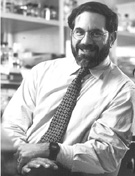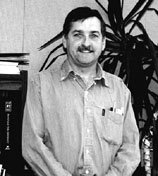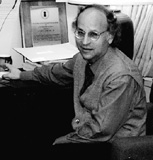
| T H E N I H C A T A L Y S T | M A R C H - A P R I L 1 9 9 8 |
|
INTRAMURAL BUDGET HOPES HIGH, BUT NOT OUT OF SIGHT |
by Celia Hooper |
The budget news for NIH was so good that NIH Director Harold Varmus had the place of honor at the State of the Union Address--in the gallery beside First Lady Hillary Rodham Clinton.
The seating arrangement presaged not only a passage in the president's address extolling NIH research as a "gift to the millennium" but also the generous treatment NIH would receive in the president's forthcoming budget proposals.
Reaction from NIH quarters to the proposals was swift and delighted. "The President's budget for the National Institutes of Health calls for an unprecedented and dramatic increased investment in medical research of more than $1 billion in FY 1999. No other Administration has asked the Nation to place such a high priority on medical research," proclaims the NIH budget press release. "Everyone is a winner in this budget," said NIH Director Harold Varmus at a news conference. In its February 6 issue, Science quotes HHS Secretary Donna Shalala as saying NIH institute directors are "ecstatic."

|
|
| Three Cheers: The State of the Union on January 27 looked good to HIllary Rodham Clinton, Harold Varmus, and Tipper Gore |
"I think the words 'pleased' and 'grateful' are better than 'ecstatic' to describe my feelings about the FY99 budget," says newly appointed NIDCD director James Battey. NIMH director Steve Hyman comes closer to being ecstatic: "I am extremely happy."
The proposal President Bill Clinton sent to Congress on February 2 recommends an NIH budget of nearly $14.8 billion--an overall 8.4 percent increase over last year, with a 6.1 percent boost for the Intramural Research Program. The president's plan envisions an increase of almost 50 percent in NIH's budget over the next five years, and the proposed increases for the extramural budget next year should generate 8,267 new Research Project Grants, bringing the total number of grants to more than 30,000--an all-time high. Also included in the president's budget is a recommendation to raise stipends for scholars in the National Research Service Awards program by 25 percent.
Hyman says what pleases him most about the new budget is its emphasis on sustained support of NIH--a concept that has also found favor among members of Congress. The concept is one that HHS Secretary Shalala has been pushing hard, in part as the result of ongoing conversations with NIH Director Varmus on the importance of attracting and keeping promising new investigators in biomedical research. The administration is recommending doubling the size of the NIH budget over the next decade some members of Congress would like to see a five-year doubling time.
 | |
| Steve Hyman |
"The key to my happiness," says Hyman, "is not just the specific number that is in the president's budget, but the promise of stability. The NIH budget roller coaster of the past has made strategic planning all but impossible and, more importantly, has served to discourage bright young people from entering careers in science. I am enormously gratified that Secretary Shalala has focused on the need for stable growth as a critical factor in the health of American science."
One of several unknowns in the budget equation at the moment is to what extent the money derived from pending tobacco legislation will fuel increases in the NIH budget. The totality of NIH's budget increase for next year is currently assembled as part of a high-visibility collection of science and health initiatives collectively referred to as the "Research Fund for the 21st Century" in the State of the Union Address (see box).
 |
|
|
|
Diane Wax, NIH associate director for legislative policy and analysis, says the source of money for the Research Fund--and thus NIH's budget increase--is the tobacco legislation. Wax says many experts on Capitol Hill doubt that Congress will manage to resolve, in this very short election-year session, the extremely complex swarm of tobacco issues, bills, and even legal entanglements completely outside the legislative purview.
It's uncertain where that would leave NIH's budget increase. With no tobacco funds, Wax points out, the House and Senate committees that consider the HHS budget are back to their bottom line--a limited pot of money that must be distributed among numerous departments and programs.
Even if NIH remains the top priority it has been for the committee chairmen, Rep. John Porter (R-Ill.) and Sen. Arlen Specter (R-Pa.), without the tobacco money, budget increases for NIH could be smaller or at least more politically painful and could entail making difficult trade-offs with other programs. "I'm not sure we can know at this point," says Wax, "but they just don't have enough money to work with, and there's a limit to the possible increases to give, even with the president's recommended 8.4 percent."
But Hyman says support for the president's budget increase should remain solid, and NIH must start planning now, even if Congress isn't able to come to closure on the tobacco issues. "Secretary Shalala has said publicly that the NIH budget increase is not dependent on tobacco legislation. Although we understand that there is a serious political process ahead in consideration of the budget proposal, we clearly must plan for the opportunities created by potential budget increases."
NIMH, like other institutes, is getting busy. "For NIMH the planning process has involved our national advisory council, working groups that have reported publicly to council, our various constituency groups, and NIMH staff, and it has also involved collaborative interactions with other ICDs that fund neuroscience research," says Hyman. Some of the scientific opportunities NIMH is eyeing include the genetics of mental disorders, neuroimaging, clinical trials focused on the needs of children and adults with serious mental disorders, studies of gene expression in the brain (the Brain Molecular Anatomy Project), studies of brain development and brain plasticity, the neurobiology of emotion, and investigation of risk factors that lead to mental disorders in children,with a view to developing preventive interventions.

|
|
|
|
Battey says NIDCD also has some priorities in mind. "We hope to put a number of initiatives on line in response to FY99 increases. These include: 1) new approaches to the prevention, diagnosis, management, and treatment of otitis media 2) molecular mechanisms of sensory neuronal regeneration 3) diagnosis and intervention strategies for neonates with hearing impairment 4) functional real-time neuroimaging to identify brain activity patterns associated with normal and disordered communication 5) identifying genetic bases for human communication disorders 6) research into pathogenesis and intervention strategies to ameliorate specific language impairment 7) research on the related subjects of noise-induced and age-related hearing impairment and 8) increased support for clinical investigators and first-time RO1 grant applicants."
NIDCD intramural research plans emphasize the genetics of human communication disorders identifying and developing mouse models of hereditary and environmentally induced hearing impairment expanding a collaborative effort between NIDCD, NCI, and NIDR to study the pathogenesis and treatment of head and neck cancer developing a vaccine against otitis media and the use of functional neuroimaging in studying the pathogenesis of human communication disorders.
Another budget unknown is how much earmarking will carve up the NIH increase. In the president's budget, specific areas of emphasis are cited, including cancer and diabetes research, but the Research Fund--at least in its original conception--is intended to serve the broad range of laboratory and clinical research, cutting across disease- and institute-specific lines. In the past, often to the quiet dismay of NIH directors, the NIH budget has lost versatility after being heavily earmarked for special interests and particular disease research areas championed by members of Congress.
How the money designated for the NIH intramural research as a whole is portioned out among its components is another unknown. Although the Clinton budget calls for a 6.1 percent increase overall, this doesn't necessarily mean that each intramural program will see exactly that increase--or any increase, conceivably. Each institute and center will decide on its specific intramural budget. Battey, who continues as acting scientific director of his institute, says, "Our IRP is about 7 percent of the NIDCD budget at present. I would hope to be able to support growth at a rate equal to or slightly exceeding the annual increase received by the NIDCD in total."
 |
Arthur Levine, scientific director of NICHD, expects FY99 budget increases to have a more significant effect on extramural than intramural activities--bringing more new investigators into the grants pool and sustaining a larger number who are continuing in that pool. "The effect on intramural research will be modest in most institutes," Levine says--"little more than keeping pace with inflation." But realistically, he says, "Given the space and FTE constraints on the intramural program, it would be difficult to add a significant number of new research programs even if more money were at hand. We should applaud this level of support for the totality of biomedical research, looking beyond our own walls."